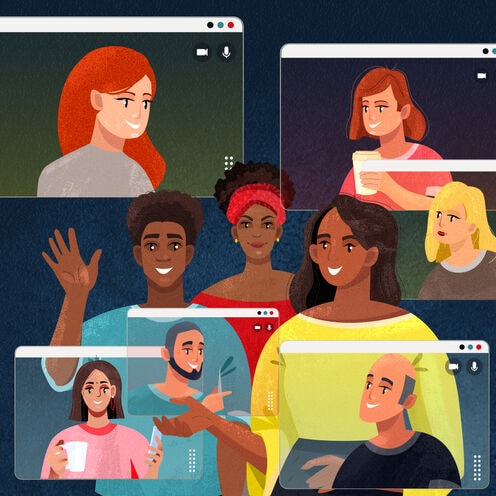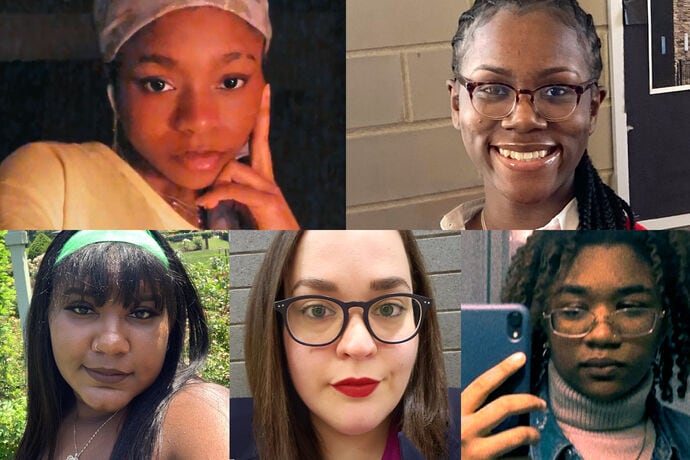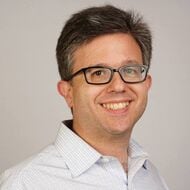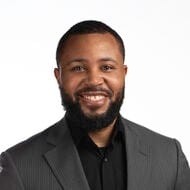
When Teachers Struggled to Address Racism, These Students Showed Them How
Amid the protests after George Floyd’s murder, a group of students found their collective voice to make change in their school and beyond.
After George Floyd was murdered in May 2020, students at Gwendolyn Brooks College Preparatory Academy in Chicago found themselves in the center of the protests, which consumed their neighborhoods. Many local stores closed amid looting. Arrests and occasional violence took place practically outside students’ windows.
For so many of the students, who are overwhelmingly Black and Latinx, schoolwork was far from top of mind. Nevertheless, finals and end-of-year projects loomed.
Given the upheaval in the community, students expected to hear of delayed deadlines and postponed tests over that last weekend in May. Instead, many of their teachers—who are largely white and live outside of the neighborhoods in which the protests were intensifying—continued communicating about schoolwork as if nothing else was going on. Even as students texted each other comfort and support, most heard nothing from their teachers about what was happening in the world around them.
“I wanted compassion from my teachers and I wasn’t receiving it,” said Kyla Lee, who was then finishing her sophomore year.
She and other students said they were looking for nothing more than acknowledgment and empathy, a check-in to see how they were doing.
“We were like, ‘We understand that this is not your job, but it is your job to make sure the students that you're teaching are well. We can't be focused if you're trying to change the subject off of things that are happening,’” Anu Atomori, another then-sophomore, said.
On the following Monday, it was similarly business as usual at the school, a selective-enrollment high school of about 1,000 students on Chicago’s South Side. That’s when a group of sophomores decided to speak up, writing an email with the subject line “Disappointment & Sadness” that 111 members of the class signed onto. They waited until midday to give teachers a chance that morning to make up for the weekend’s silence. Then they sent the email to Brooks’ leaders.
“We are disheartened by your silence and some of you all’s disregard for both our mental and emotional health,” the email read. “Many Brooks students were out protesting peacefully and standing up for the injustice we face on a regular basis. As students, we look to the teachers and staff to provide guidance and help on issues this great. Your silence hasn’t gone unnoticed.”
“We hope that you find it in yourselves to put your students’ health above their GPAs and show a little more consideration for those that are truly hurting and suffering during this time,” the email concluded.
That email would set in motion a series of conversations and events at the school and beyond, with students taking the lead to educate their educators. A year later, Brooks students and faculty alike describe an improved atmosphere in which teachers are much more responsive to and centered on students’ needs and interests, changes they attribute to what took place after sending that email. This, in turn, would plant the seeds of a new nonprofit organization dedicated to bringing a student-centered antiracist message to other schools and educational organizations.
Space to Be Heard
Kerry Dolan (Chicago ‘08), Brooks’ assistant principal, says she was “deeply touched” after reading the email, and she understood the sting of students’ disappointment in the silence of their teachers.
Dolan, who is white, says her immediate reaction was that “we needed to find a venue to give students the space to share their feelings, to share their thoughts, to share their experiences in a way that allowed staff to hear them and really not just listen to them, but hear them.”
Dolan scheduled a meeting with the students for that afternoon. Though the students had asked that their email be forwarded to the full faculty, school leaders decided not to, because the email had named and thanked specific teachers who were supportive. Dolan said she feared that would “put people whose names weren't in there on the defensive.”
It was a decision that initially stung some students. “It felt like we weren't being listened to, again, for a second time after we tried to put an email out there to be listened to,” one student who signed the email said. But that afternoon, Dolan and the school’s principal met with the students and made clear they wanted to find another way for them to articulate their feelings to the broader school community.
They landed on the idea of having the students create a professional development (PD) session for the school staff. “We just wanted a space for our voices to be heard and we ended up getting that space,” Lee, one of the students, said.
Ariana Hinton, another of the students, said she realized that if she and her peers wanted to see a change in the school, it was up to them to make it happen, whether that was fair or not. Dolan and other teachers “made it very clear that this was not something that we should have had to do,” Hinton said. “This is one of those moments where the roles had to reverse in order for us to get somewhere, and I was fine with that.”
A Far-Ranging Professional Development Session
About a dozen students got to work preparing the PD, deciding on an approach, divvying up tasks and parts, diving into research, and setting and meeting deadlines. They allowed themselves one week to create the program, at times meeting for three or four hours. Dolan and another teacher offered support and advice.
They developed a roughly 90-minute virtual session, presented twice to accommodate teachers’ schedules. In it, they didn’t just address the immediate issue at Brooks; they delved into the history of systemic racism in America and in the country’s education system. The PD featured testimonials and photos from students’ experiences at the George Floyd protests and a poem, “The Plague We’ve All Gotten Used To,” by one of the students, Kamari Copeland.
Students addressed and debunked racist stereotypes and included calls to action, such as “Don’t just be ‘not racist,’ be anti-racist,” and “Use your privilege to emphasize POC [people of color] voices.” They offered specific proposals for improving Brooks’ school culture, such as providing more in-depth programming for Black History Month. “As educational staff members you hold a large amount of authority and you set an example to hundreds of students. Your authority doesn’t help anyone if it’s not being put to good use,” they said.
The PD concluded with a list of resources for teachers.
“I felt under-qualified but overqualified at the same point because I was teaching struggles that I had been going through my entire life to people who knew nothing of them,” Lee said of the experience. “I guess the benefits definitely outweighed the doubts.”
The Ethics of Asking Students to Educate Their Teachers
Those doubts loomed over the project—for students and faculty alike—as they considered whether it was appropriate for youth, especially students of color, to be called on to educate their mostly white educators about the history of racism in America.
Atomori said it’s difficult “to relive everything and just explain it to you when you should just go out and educate yourself. It might be hard, it might feel uncomfortable, but that's everything in life.” “At the end of the day, you have to do what needs to be done, if they're not going to educate themselves, you have to step up,” she said.
Attending the PD, Julia Ciciora, a Brooks math and science teacher, said she was proud of the students and knew “it was coming from a place of pure heart.” And yet Ciciora, who is Latinx, also said she felt “really just confused about why it was coming from my students who needed to be taking care of their own mental health instead of re-traumatizing themselves by telling their experiences about why this is necessary.”
At the end of the PD, teachers asked questions about how they could better support students. Their written evaluations of the PD were universally positive and filled with commitments to do better. Ciciora concluded—like Lee and the other students—that having the students run the PD was the right thing to do. “I know that it changed a lot of minds in our building, a lot of teachers in our building as a result,” she said.
A Changed School Environment
In his written evaluation following the PD, government and economics teacher Steven Mullooly committed to reaching out to students more regularly and integrating issues such as “reparations and racism” into his curriculum. Then Mullooly, who is white, spent time that summer immersing himself in some of the anti-racism literature the students recommended, as well as his own research—an effort he says was partly inspired by the PD.
Mullooly, who has spent nearly a decade of his 20-year career at Brooks, said he previously worried primarily about covering the vast amount of material the Advanced Placement curriculum calls for. But he came into this school year determined to approach his classes differently—to go deeper into the topics such as racism that most resonated with his students, and to make time during classes for them to discuss how they are feeling about difficult events. He’s used an article about racism in his economics class and discussed Black Lives Matter in his government class. Mullooly credits the student-led PD with spurring this effort. The new approach, he says, “has given my curriculum new life.”
After the Jan. 6, 2021 insurrection in the Capitol, Mullooly had planned to focus discussion on whether the president should be impeached because of the riot. But after listening to his students talk about their own reactions, he quickly switched gears to focus on what they were zeroing in on: race.
“The lesson became about how media portrays white militias, then how Black Lives Matter are viewed in the media,” Mullooly said. “The lesson took a change because of the students' demands to be heard and what they're interested in.”
Several students said they, too, had noticed changes—some subtle, some more obvious—like those that took place in Mullooly’s class.
“When we first got to school, one of our first English assignments was about redlining. I’ve never learned about redlining in school,” Lee said. “That was like, ‘Whoa, not only were you listening to the PD, but you also implemented it in your lesson plans.’ It wasn’t anything that I’ve ever seen before.”
The students who ran the PD will sometimes comment in their group chat on the ways teachers have integrated new approaches or topics into classes, Jada Ceaser, one of the students, said. At the beginning of the school year, her U.S. history teacher spent time discussing with the class what they want to learn rather than issuing a traditional syllabus. “Overall, I've noticed when very big events happen, teachers are now more willing to open that space to talk about it rather than moving on, which I feel like didn't really happen before in my previous two years,” Ceaser said.
Dolan has seen such changes schoolwide. Brooks launched a student-run literary journal, The Balm, as a window for the whole school community to learn what’s on students’ minds. Another example: the teacher-staffed “equity committee” has tripled in size this year. The group, which had previously offered space for reflection and discussion, is focusing on taking actions to further grading equity at the school, among other things, Dolan said.

What Makes Student Movements Successful
Versions of what’s happening in Brooks are playing out in schools and colleges around the country. It is more common than ever for schools to make spaces for students to have a say in school issues, said Jerusha Conner, a professor of education policy at Villanova University who studies student voice and youth activism movements. However, she said, there is a long way to go.
A recent survey Connor cited found only 2% of high school students felt that they had a voice in decision-making at their school. Echoing what happened at Brooks, Conner said that one student quoted in that study, when asked how her school came to give her this space to speak up, replied, “They didn't—I just screamed loud enough until they heard me."
When students do organize, Conner said, it is sometimes about issues of comfort such as the cafeteria food. But, she said, students also often address issues of deep concern about school culture, policies, and identity issues, including disciplinary policies and practices, police officers in schools, and sexism, racial justice, and LGBTQ students’ rights in schools.
The teachers and school leaders who engage with students on committees, advisory boards, and the like “must be prepared not only to engage in genuine power sharing with students but also to confront issues that are uncomfortable or that they may prefer not to have surfaced,” Conner said. “Youth know when they are being manipulated, tokenized, or coopted to serve adult agendas, and any effort that has the whiff of such a strategy can backfire spectacularly.”
Efforts to center on student voice and include students in school decision making tend to be most successful when they are actively supported by an adult ally or an external nonprofit, said Dana Mitra, a professor of education at Penn State University and an expert on student voice efforts.
“At the core of this, it's this belief and affirmation that there is knowledge there that no one else could share. That's really powerful,” Mitra said. For the adults involved, “the magic is being behind the kids, not leading it, so that the youth are forward and their support behind it.”
It’s also helpful when the school—and the district—have a strong culture and history of student activism, Mitra, added, citing Chicago as one city that exemplifies this tradition of support.
Brooks, of course, is in Chicago, which runs many student voice committees in schools. And from well before the events of last spring, Dolan said, the students had “powerful advocates in the building for student voice,” including its own very active student committee. Soon, there would also be an external nonprofit lifting their voices.
Creating a Student Voice Nonprofit
The success of the student-led PD sessions in summer 2020 sparked an idea for Dolan: What if the students delivered a version of their presentation to other organizations?
Weeks later, in July 2020, the students ran a session at Chicago Public Schools’ annual Summer Leadership Institute, which about 80 school leaders and district officials from across the city attended virtually. Though similar to the PD they ran at Brooks, this version focused more on how school leaders can amplify student voices, especially at schools composed largely of students of color. The students later delivered a virtual PD for staff members at Embarc, a Chicago nonprofit that works in several local schools focusing on issues of identity and race prevalent in the city’s schools.
Dolan’s experience advising and encouraging the students led her to reflect on how little space is generally given in educational professional development programs to those most affected by the education system. “Why is student voice not a larger component of learning?” she said.
“It just seemed like such an obvious next step and such a glaring omission historically in terms of professional development offerings, that I was just floored for a moment.”
Student-Led Ed was born.
The nonprofit organization aims to provide youth-led training programs to help educators be more responsive to student needs and elevate the voices of marginalized students—igniting transformations similar to that at Brooks.
Dolan aspires to pay participating students for their efforts and offer college advice and life coaching—starting with those students who led the Brooks PD.
“As school leaders and as teachers, we rely on the free labor and the ideas of students a lot. If we're going to be an organization that talks about the value of student voice, we actually have to put our money where our mouth is and model that,” Dolan said.
While fundraising efforts continue, the organization has begun its life coaching program for student participants and received its first grants. One grant from National Geographic Society's COVID-19 Remote Learning Emergency Fund for Educators will fund a summer project in which the students will create six public webinars, a sort of “anti-racism 101,” according to Dolan.
Dolan and the students have big plans for what lies ahead.
“I ultimately hope that more educators see just exactly how important it is to bring in equity into schools,” Lee said. “A lot of educators always preach that they just want to prepare kids for the real world, but they don’t understand how to do it. I really do hope that our lessons and our professional developments, the hour and a half sessions that we give, just allow for teachers to reflect and understand how they can be better teachers to the kids that they teach every day.”
This is the first in an occasional series on youth activism—how students are organizing and lifting their voices to bring change to their schools, communities, and the wider world.
We want your feedback. Share your thoughts on this story or suggest other stories for us to pursue.
Sign up to receive articles like this in your inbox!
Thanks for signing up!
Content is loading...








